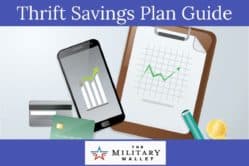My mission is to share the story of how my family is seeking to become debt free, achieve financial independence, and retire early. This is often abbreviated “FIRE.”
As military members, we have some advantages to reaching financial independence at an early age. The two biggest advantages are the military retirement pay and benefits, and the Thrift Savings Plan. Today we will focus on why the Thrift Savings Plan is such a great benefit for military members and how you can use the TSP to invest like a world-class investor.
Table of Contents
Highly Respected Investors Would Drool to be Part of the TSP- Lucky Us!
The military recently overhauled their retirement system with the Blended Retirement System. The current High-3 military retirement plan only offers a cliff-vesting pension. It’s all or nothing. If you don’t retire with 20 years or more, you walk away from the military with no retirement benefits except what you were able to save on your own.
The Blended Retirement System, however, keeps the pension (at a lower rate) but also adds a defined benefit in the form of matching Thrift Savings Plan contributions. This is an incredible incentive to save in the TSP. As a result, the TSP is expecting a huge influx of investors in 2018. The BRS will make TSP contributions mandatory for new service members in 2018. Some current service members can switch into the BRS and get up to a 5% contribution match in their TSP. 2018 will see a big enrollment jump with steady growth in TSP enrollment in years to come.
Some military investors are wondering if the TSP is the best way to guarantee their future. Many more have no idea where to begin with investing. Others are suspicious that their mandatory 1% contribution will be made without their say in how its invested.
Let me put these concerns to rest. The TSP combines two elements recommended by some of the most respected investment gurus in the world: Low fees and passive index investing.
Thrift Savings Plan – Industry Leading Low Fees
For those who have never invested before, rejoice! Not only does the TSP simplify investing, but it does so at an incredibly low cost.
All investments have associated costs. If you trade stocks you pay a trading commission through your brokerage account. If you buy mutual funds you may pay front load or back load fees on top of management expenses.
These fees reduce your investment every year, whether it makes money or not. Industry-standard expenses of around 1.0% can reduce the growth of a portfolio by over 30% over a lifetime! Larger expenses, such as 2% or 3%, can reduce your returns by over 50% and 60% respectively.
Lower Fees Means More Money In Your Pocket
As you may have guessed, keeping your investment fees to a minimum is essential to reaching financial independence. The more money you keep in your portfolio, the faster it compounds, and the faster you can reach your investment goals.
How much should you pay? There isn’t a hard rule, but in general, lower can be better. For example, Vanguard, the darling of low-cost investors and one of the lowest cost investment platforms, charges expense ratios that start at 0.05% and go up from there.
The TSP charges on average about 0.038%! You are automatically keeping more of your money every year.
This is precisely what John C. Bogle, founder of Vanguard and the passive index fund, tells us is best. Index funds have been so successful that a massive amount of capital has flowed into them over the past few years. In his seminal book, The Little Book of Common Sense Investing, Bogle starts out with:
“… the winning strategy is to own all of the nation’s publicly held businesses at very low cost. By doing so you are guaranteed to capture almost the entire return they generate in the form of dividends and earnings growth.”
The TSP allows you to do just that.
Passive Index Investing
There is a reason investing can get a bad rap—many people treat investing like gambling. Timing the market, trading hot stocks, and paying high fees to try to find the best fund manager is gambling. The IRS may even penalize you for some of these activities through the tax code.
The TSP utilizes Passive Index Investing. The five core funds track broad segments of the market, like the S&P 500, ensuring you get a share of essentially the entire market’s gains, just like Bogle suggests.
Thrift Savings Plan fees are low because the TSP is managed passively, rather than actively (where a fund manager tries to time the market and pick stocks for you). Warren Buffet reportedly made a million-dollar wager with some active hedge fund managers in which Buffett bet the active managers couldn’t beat an indexing approach to investing over 10 years. Over the past decade, Buffet has been right—he’s beating the active fund managers +85% to +22%. (The winner of the million-dollar wager will donate the proceeds to charity).
Using Index Funds in the TSP
When you invest in the TSP you get to choose your own basket of funds, although by default your money will begin in the low-earning, but very stable, G fund until you set up your preferences. You can pick from five core funds that cover much of the world market. These funds cover large cap US stocks (C Fund), small cap US stocks (S Fund), international stocks (I Fund), government bonds (G Fund), and government, corporate, and mortgage backed bonds (F Fund).
The TSP also offers “Target Retirement Date” Funds, which are comprised of a combination of the previously mentioned funds. These funds automatically balance your portfolio according to your expected retirement date (from all working, not your anticipated military retirement date). These funds help manage your risk, including more risk (and more room for growth) when you are young and less as you age.
The TSP Offers Lifelong Benefits
Jim Collins, who has written a wonderful blog and book about his freedom-inducing inventing philosophy, is a huge proponent of low fee index investing, including the Targeted Funds.
Jim recommends that civilian investors convert their 401k to IRA’s when they leave regular employment since 401K’s often don’t offer low fee investing. He departs from this advice when it comes to the TSP. After you leave military service he would recommend leaving your money in the TSP, and converting any new 401k’s back into it after you leave your bridge career. I review the rest of his book here:
I review the rest of his book here: The Simple Path to Wealth Book Review.
If you aren’t sure you are comfortable with investing in the TSP, or are considering investing only up to 5% for the match, I encourage you to shop around for a better way to save for retirement. But I don’t think you will find one.
I am not a financial advisor and these opinions are my own.



Comments:
About the comments on this site:
These responses are not provided or commissioned by the bank advertiser. Responses have not been reviewed, approved or otherwise endorsed by the bank advertiser. It is not the bank advertiser’s responsibility to ensure all posts and/or questions are answered.
Liz says
I am so stoked for this new plan! I am Active Duty Air Force. I’ve been telling all my co-workers who have never invested that this is the time to start! They are all so skeptical because they can’t take their eyes off of the High 3 Plan. Most of us won’t even make it there!
I hope military personnel will open their eyes and realize how great this opportunity is!
John @ MilitaryFIRE says
Liz,
You’re right, this is an exciting opportunity- there is no excuse to not invest now that you will get a TSP match. Switching to the BRS isn’t for everyone, however. Its essentially a hedge against not making it to 20 years. Over at militaryfire.com I discuss why I’m not buying into the BRS hype- pretty much I hope to make it to 20, am skeptical that the coast guard will pay out the 12 year bonus, and I’ve done the math and the (invested) match is only worth about $95k to someone in my position who makes 20 years under the BRS, which is far less that the difference in High 3 and BRS pensions over a lifetime. I encourage everyone who has the option to switch to DO THE MATH (rule 1) and examine their life goals before making an irrevocable decision.
…Who know, I might change my mind still.
Good luck!